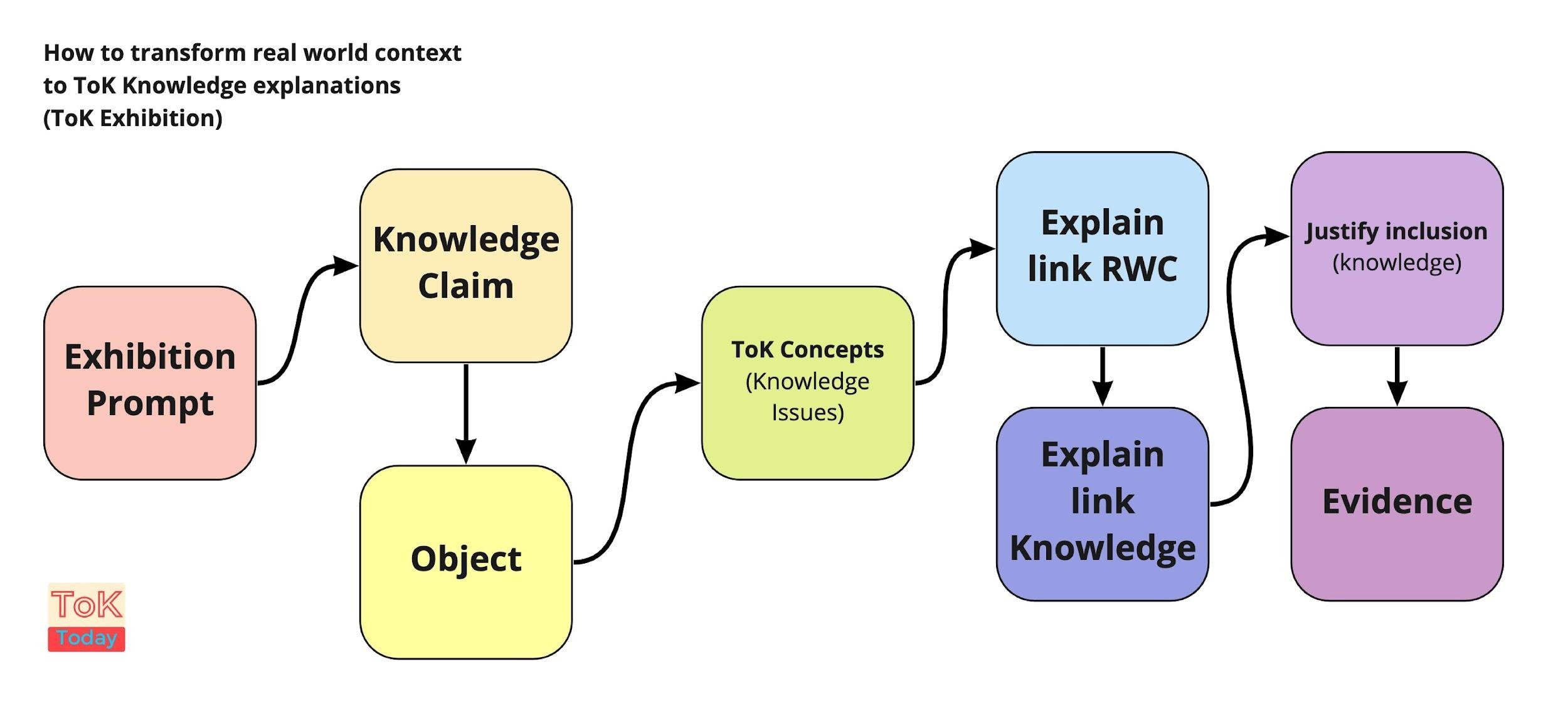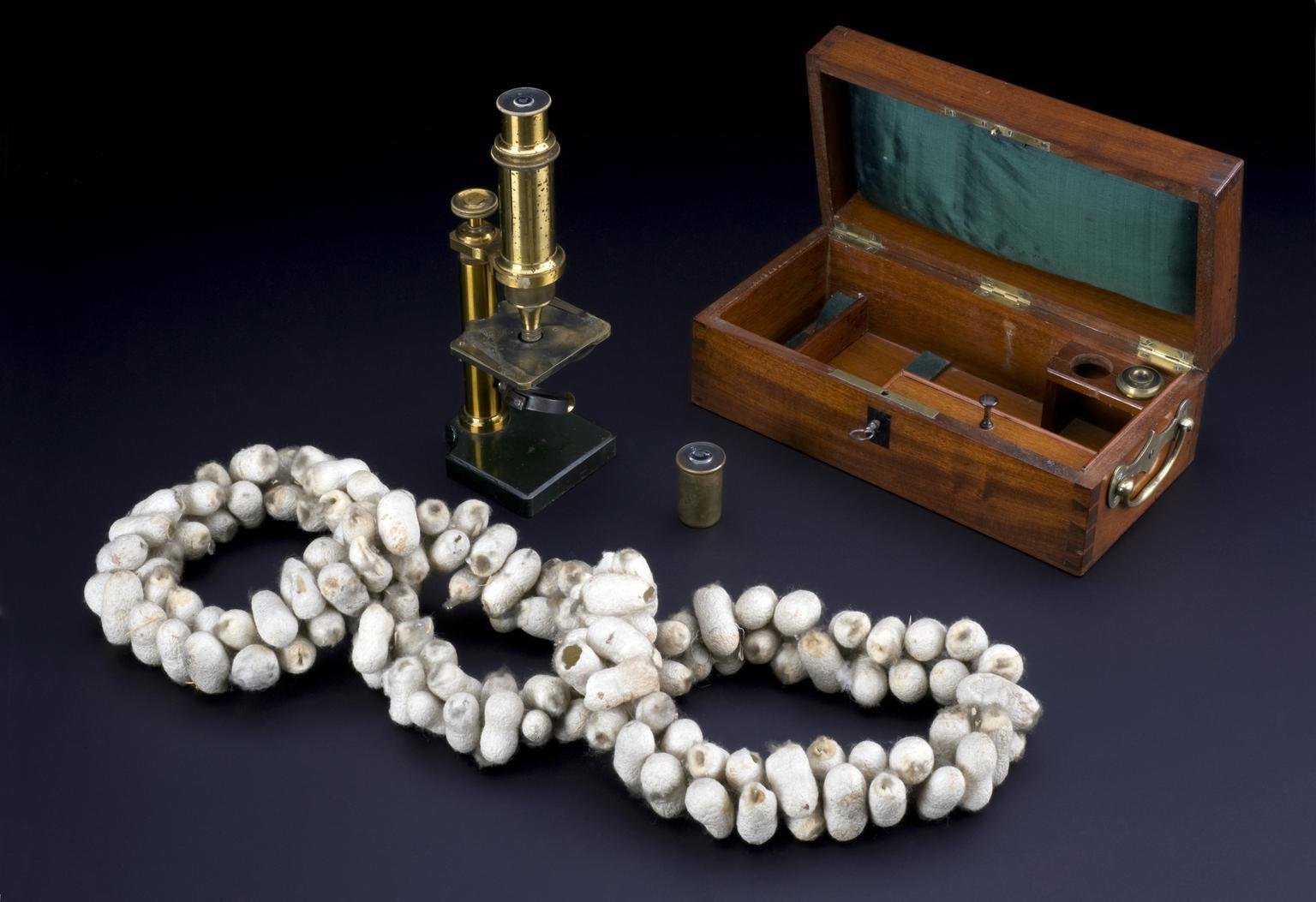What constraints are there on the pursuit of knowledge ? (ToK Exhibition #15)
Get a copy of TOK Exhibition Prompts 11-15 Explained at this link.
Detailed explanations of each prompt, including suggestions for knowledge claims and objects that could be used in the Exhibition.
Below is just a summarised example of a commentary for the ToK Exhibition prompt "What constraints are there on the pursuit of knowledge ?" (the book Prompts 11-15 Explained has a more detailed exploration of this prompt).
A video overview of this Exhibition Commentary is available at this link.
Exhibition Commentary Structure.
I recommend using this structure for writing the commentary for each object.
ToK Concepts should only be included if they're relevant, don't 'force' them in for the sake of using them.
'Evidence' can be citing academic research evidence, a newspaper article, or details about the object itself. There should not be a separate evidence section at the end, just weave the 'evidence' into the commentary.
The overall ToK Exhibition Commentary structure is shown below.
Key terms in this IA prompt.
Constraints.
Constraints can be understood as barriers, obstacles, curbs, hindrances or restrictions on the pursuit of knowledge. This can cover a wide range of factors from the knowledge producer themselves, the values underpinning a subject, pre-existing knowledge to the methodology (incl. technology) of knowledge production.
The pursuit of knowledge.
The term “pursuit of knowledge” is not specifically defined in the IB ToK Guide (International Baccalaureate). However, from reading the ways in which the term is used in the IB ToK Guide we can see that they are referring to a wide breadth of ways in which knowledge can be attained. Including the production of knowledge in a conventional manner, and formal and informal learning (such as in school). It does seem to imply a proactive approach on the part of the pursuer of knowledge.
It is recommended that students closely tie their response to this term (the pursuit of knowledge) to demonstrate to the examiner that they are directly addressing the prompt.
Knowledge Claims.
It is recommended that you develop three knowledge claims (one for each object) BEFORE you identify objects. If you have one distinct knowledge claim for each object it is easier to write a knowledge discussion which is specific to that object.
These are just 3 examples of the many knowledge claims that you could develop for this prompt:
Knowledge Claim 1:
The value framework of an authority figure / knowledge gatekeeper can be a constraint on the pursuit of knowledge.
Knowledge Claim 2:
The tools available to a knower can be a constraint on the pursuit of knowledge.
Knowledge Claim 3:
The value framework of a discipline / area of knowledge can be a constraint on the pursuit of knowledge.
In the commentary below I have included the following 3 headings to help you to see the structure, you should not include these headings in your own commentary:
Link between real world context of object and prompt.
Link between object and knowledge argument one.
Justification for inclusion of object one.
The ToK Exhibition Commentary.
Object one: Newspaper Report about a School Principal who was forced to resign after showing her students a photograph of the statue David by Michelangelo (Radford).
Photo Credit: BBC News (Radford)
Link between real world context of object one and prompt.
In March 2023 a Florida high school principal had to resign under pressure from some of the parents of students at her school who disagreed with her showing the students a photo of Michelangelo’s statue David. The parent’s actions were a constraint on the future knowledge of the students at the school (who will not learn about this statue, others like it, and its relevance in art history). The parent’s actions are also a constraint on the knowledge of the Principal who had to resign, and future Principals of the school.
Link between object and knowledge argument one.
The parents who obliged the Principal to resign represent an authority figure, or external power, in the definition of legitimate knowledge. Their power to influence what knowledge is deemed appropriate for inclusion in the school curriculum gives them the role of gatekeepers of knowledge. In such a role any selection of knowledge from omission from the school curriculum is a constraint on the pursuit of knowledge of the student’s at the school.
Object one demonstrates that external authority figures / bodies acting in the role of knowledge gatekeepers are a potential constraint on the pursuit of knowledge of those over whom they have authority.
It is important to note the distinction between the constraint over the pursuit of knowledge, and the constraint on the knowledge itself. Gatekeepers may constrain the pursuit of knowledge in the context / knowledge sphere within which they have influence, but the knower may still pursue knowledge via alternative methods or routes. In the case of Object 1 the students at the school could learn about Michaelangelo’s work outside of the school environment.
Justification for inclusion of object one.
Object one is included because not only does it demonstrate the prompt, but it exemplifies the irony of the renaissance movement. Michelangelo was a significant influence in the renaissance movement, a group of knowledge producers who advocated a liberal-rational approach to knowledge, including greater freedom of thinking and speech. The parents at the Florida high school advocated censorship of knowledge, and value laden interpretation of knowledge. As such, object one demonstrates that attempts to increase access to knowledge can lead to greater constraints on knowledge.
Object one word count: 351
Object 2: Pasteur’s Microscope used to study Silkworm diseases 1860-1870. (Pasteur et al.)
Photo Credit: (Pasteur et al.)
Link between real world context of object two and prompt.
Object 2 is the compound microscope used by Louis Pasteur to study diseases in Silkworms in the 1860s.His studies led him to develop a method for sterilising silkworm eggs to prevent the spread of the disease. Pasteur used this knowledge to further develop the germ theory of disease. He would not have been able to scientifically demonstrate germ theory without the microscope. As such Object 2 demonstrates that the technology that is (and is not) available to the knower can be a constraint on knowledge.
Link between object and knowledge argument two.
Microscopes were developed in the late 16th century. Over time, microscopes were continually refined and improved. The invention and improvement of this technology enabled Pasteur to identify and understand the physical evidence to establish germ theory. He conducted a series of experiments using microscopes to study the causes of fermentation and putrefaction through which he demonstrated that microorganisms were responsible for these processes, rather than spontaneous generation, as many people had believed. If Pasteur had not had access to the technology of the microscope he would not have been able to see the evidence needed to confirm germ theory. Previously other scientists (e.g. Nicolas Andry (Seymour and Ernst)) had hypothesised the role of microorganisms in the role of diseases, but had been unable to confirm the theory with visual evidence (realised by the microscope). As such the microscope demonstrates that access to technology enables the discovery, or construction, or knowledge. Conversely, a lack of technology is a constraint on the pursuit of knowledge. Some scientific theories, such as the establishment of Dark Matter, are currently contingent upon the development of new technologies which will enable their confirmation.
Justification for inclusion of object two.
Object 2 is included because it highlights the crucial role that technology holds as constraint, or enabler in the pursuit of knowledge. Pasteur’s use of the microscope in developing the germ theory paved the way for the development of antibiotics and other treatments for bacterial infections. This shows that lack of technology can be a central constraint in the pursuit of knowledge.
Object 2 word count: 338
Object 3: A photo of the Princeton Engineering Anomalies Research (PEAR) Laboratory.
Photo credit: (“Introduction to the PEAR Lab”)
Link between real world context of object three and prompt.
Object 3 is the Princeton Engineering Anomalies Research (PEAR) Laboratory established in 1979 by Professor Robert G. Jahn to study the ability of the human mind / consciousness to affect physical objects. The lab used conventional scientific experimental design as a component of a normal established scientific methodology. Jahn found small positive highly significant statistical effects ( (“Introduction to the PEAR Lab”). However, the lab was closed down in 2007 due to accusations that it was practising “pseudoscience” (“'Pseudoscience' lab closes at Princeton – The Daily Free Press”). Scientific funding bodies, and university managers, felt that PEAR transgressed the acceptable norms and values that underpin the classification of the discipline Physics. As such, object one demonstrates that the values, or conventionally defined scope, of a discipline (such as Physics) can be a constraint on the pursuit of knowledge.
Link between object and knowledge argument three.
The research at PEAR challenged some of the fundamental principles of modern day Physics. The research at PEAR looked at whether the power of the human mind (or human consciousness) could change the direction motion of physical objects. As such the research challenges Newton’s Laws of Motion (“Newton's laws of motion | Definition, Examples, & History”) and Newton’s Law of Universal Gravitation (“Newton's law of universal gravitation”). These laws are fundamental to the paradigm of contemporary physics. When Jahn started to report statistically significant experimental results many in the scientific community were concerned about the methodology of the research. Underpinning these concerns was the challenge to the established paradigms of contemporary physics (as enshrined in Newton’s laws) (“'Pseudoscience' lab closes at Princeton – The Daily Free Press”). By closing PEAR the Physics establishment silenced the challenge to the norms and values of the discipline. As such, PEAR laboratory demonstrates that the norms, values and paradigm of a discipline can be a constraint on the pursuit of knowledge in that discipline.
Justification for inclusion of object three.
PEAR is included because it shows that whilst the norms and values of a discipline define the content, and methodology, of a discipline they can also constrain the evolution of the discipline. The research at PEAR had the potential to increase the insight and sophistication of the principles of contemporary Physics. In order to evolve any discipline new knowledge will inevitably challenge pre-existing conventional beliefs. Object 3 demonstrates that such a challenge can be very difficult to accept. As such disciplines are more prone to stasis than to evolution in the development of knowledge.
Word count for object 3: 355
Total Word Count: 1044
(I have some editing to do).
Works Cited
da Volterra, Daniele, et al. “Michelangelo.” Wikipedia, https://en.wikipedia.org/wiki/Michelangelo. Accessed 4 May 2023.
International Baccalaureate. Theory of Knowledge Guide. Cardiff, International Baccalaureate Organization, February 2020, www.ibo.org.
“Introduction to the PEAR Lab.” Psyleron, https://www.psyleron.com/pearIntro.html. Accessed 6 May 2023.
“Newton's law of universal gravitation.” Wikipedia, https://en.wikipedia.org/wiki/Newton%27s_law_of_universal_gravitation. Accessed 6 May 2023.
“Newton's laws of motion | Definition, Examples, & History.” Encyclopedia Britannica, 27 March 2023, https://www.britannica.com/science/Newtons-laws-of-motion. Accessed 6 May 2023.
Pasteur, Louis, et al. “Microscope used by Louis Pasteur in his investigations on silkworm diseases, Paris, France, 1860-1870.” Science Museum Group Collection, https://collection.sciencemuseumgroup.org.uk/objects/co118372/microscope-used-by-louis-pasteur-in-his-investigations-on-silkworm-diseases-paris-france-1860-1870-compound-microscope. Accessed 4 May 2023.
“'Pseudoscience' lab closes at Princeton – The Daily Free Press.” The Daily Free Press, 23 February 2007, https://dailyfreepress.com/2007/02/23/pseudoscience-lab-closes-at-princeton/. Accessed 6 May 2023.
Radford, Antoinette. “Principal resigns after Florida students shown Michelangelo statue.” BBC, 25 March 2023, https://www.bbc.com/news/world-us-canada-65071989. Accessed 4 May 2023.
Seymour, Robert, and HC Ernst. “Germ theory of disease.” Wikipedia, https://en.wikipedia.org/wiki/Germ_theory_of_disease. Accessed 6 May 2023.
As mentioned earlier, you should not include the headings (“link between”, “justification for” etc) in your own commentary.






